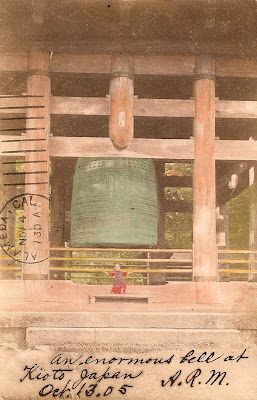
This tinted postcard depicts the Bowery in Manhattan, probably between 1901 and 1905. It was published by A. C. Bosselman & Co. of New York but like most better quality postcards at the time it was printed in Germany.
The tinted halftone process added layers of printed color to an original black and white image, and thus represented a kind of hybrid between photomechanical and traditional ink printmaking. The appearance of the finished image would be affected by the skill, the patience, and in some cases the imagination of the printer; details might be added or brushed out as desired. Some of the vehicles and figures shown above appear to have been retouched by the printmaker, and details like the steeple in the distance between the two converging rail lines were probably added as well.
The New York Public Library has a photograph, attributed to John Loeffler and dated 1895, that depicts a similar vista.
 (Courtesy the New York Public Library)
(Courtesy the New York Public Library)John Loeffler died in 1901; the postcard below, which corresponds closely with the Bosselman card, was published by his brother August, who was active until 1905.
 (Courtesy the New York Public Library)
(Courtesy the New York Public Library)Here is yet another version, issued by the Souvenir Post Card Co., which was active from 1905-1914. It uses the relatively crude line block halftone process.
 (Courtesy the New York Public Library)
(Courtesy the New York Public Library)In addition to the coloring, there are a number of differences between the photograph and the postcards. Whether there once existed an alternate photographic original or whether the differences were due to retouching I don't know. The general prospect looking uptown was evidently a popular one, and a number of imitations or variations were marketed. The next image, published by Valentine & Sons (active from 1907-1909), has only one train and a far less busy street, but a bridge has sprouted crosstown in the middle distance.
 (Via Wikipedia)
(Via Wikipedia)Looking from one image to another, pedestrians who stride by unaware of the photographer's presence or who may never have existed at all appear and disappear, signs leap out or vanish, streetcars and elevated trains advance like the flickering phantoms of early motion pictures. In some images trucks replace trolley cars, day becomes night, yet some of the same figures seem to stroll in the shadows of the elevated rails. Below are a few among many. The first one, by the way, is the only one that clearly depicts the casket factory sign that appears in Loeffler's photo, and thus is probably a direct descendant.




This uncredited photograph, via
the Bowery Boys, also shows a roughly similar perspective, though it doesn't seem to match up closely with any of the postcards. The "casket" sign isn't shown, but there seems to be a "coffin" one on the same building.

Here, from the digital collections of
Library of Congress, are two photographic views taken by J. S. Johnston in 1895. Either or both may have been retouched a bit.


The card below, published by the prolific Detroit Publishing Co., provides a different angle and a better view of the faces of some of the buildings on the west side of the street, including the Gaiety Musée, a famous vaudeville theatre, whose garish facade, just uptown from Glassman's Hats, is much less obvious in the other pictures. Dominating the scene is the monstrous bulk of the Bowery Savings Bank, designed by Stanford White (and now a registered landmark).
 (Via the Georgetown County Digital Library)
(Via the Georgetown County Digital Library)One of the things that appeals to me about many of these images (other than their historical content) is that they seem to inhabit a fertile middle ground, staking out various points along a spectrum between the supposedly "documentary" status of photography and the "artificial" methods of painting and drawing. (Later postcards, which fall solidly into one camp or the other, seem as a consequence far less interesting.) The same basic scene could be reshot, or an older original could be adapted, in order to include details that would make the final image more quaint or more contemporary as market tastes might demand. Complete "fidelity" in mass reproduction, at least in regard to color, was as yet impossible in any case. In my next post I'll look at a few more examples of image manipulation.
I am grateful to the phenomenal resources of the
Metropolitan Postcard Collectors Club for much of the background information above, but any confusion is my own.

























